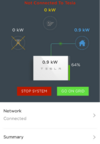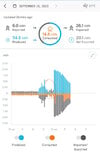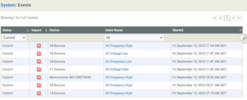Hi, first-time poster, long-time reader. I might have missed another thread explaining this issue, sorry if I have.
PV system is an 11.9kW system with IQ7+ microinverters and 1 Powerwall 2 with gateway 2.
The grid went down yesterday because of Hurricane Lee around 7pm with battery at 100% (with reserve set at 100%). The batter supplied the house overnight with about 40% remaining by sunrise. We had also lost internet overnight so I had to monitor the battery status by direct connection. I could see the PV system recharging the batteries around 8am with a good amount of sun.
Strangely when I checked the system at 10am, the battery had charged to 66% but the solar had stopped producing all together with plenty of sunshine. From 10am to 12pm, the PV system produced basically nothing, and the battery dropped from 66% to about 56%. The powerwall installer (different to the PV system installer) suggested restarting the system which I did but still no PV production.
When I asked the PV installer, they checked the logs which had a number of events saying frequency and voltage were high so the microinverters were shutting down. I can only assume that the gateway/powerwall increased frequency to shut down PV production but why would it do so at a 66% SOC? House consumption remained pretty steady between 0.7 and 0.9kW.
I've had the powerwall for about 8 months and this is the longest period of being off grid. Any ideas why this happened? Coincidentally, grid power came back at 12pm and PV production went to 100% capacity which you can see in the enphase image.
Any help is really appreciated!
Some screenshots below



PV system is an 11.9kW system with IQ7+ microinverters and 1 Powerwall 2 with gateway 2.
The grid went down yesterday because of Hurricane Lee around 7pm with battery at 100% (with reserve set at 100%). The batter supplied the house overnight with about 40% remaining by sunrise. We had also lost internet overnight so I had to monitor the battery status by direct connection. I could see the PV system recharging the batteries around 8am with a good amount of sun.
Strangely when I checked the system at 10am, the battery had charged to 66% but the solar had stopped producing all together with plenty of sunshine. From 10am to 12pm, the PV system produced basically nothing, and the battery dropped from 66% to about 56%. The powerwall installer (different to the PV system installer) suggested restarting the system which I did but still no PV production.
When I asked the PV installer, they checked the logs which had a number of events saying frequency and voltage were high so the microinverters were shutting down. I can only assume that the gateway/powerwall increased frequency to shut down PV production but why would it do so at a 66% SOC? House consumption remained pretty steady between 0.7 and 0.9kW.
I've had the powerwall for about 8 months and this is the longest period of being off grid. Any ideas why this happened? Coincidentally, grid power came back at 12pm and PV production went to 100% capacity which you can see in the enphase image.
Any help is really appreciated!
Some screenshots below





